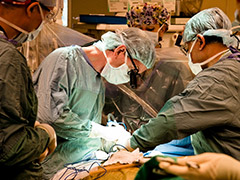Artery over vein for diabetic heart surgery
For diabetic patients requiring heart bypass surgery, the radial artery is a much better choice for bypass grafting than the saphenous vein.
A new study by a team in Sunnybrook’s Schulich Heart Centre, published in the Journal of Thoracic and Cardiovascular Surgery, found that five years or more after coronary artery bypass graft surgery (CABG), 25.3 per cent of diabetic patients receiving saphenous grafts from the leg or thigh had completely occluded, or blocked grafts, compared with 4.8 per cent who received a radial artery graft from the wrist or arm.
Bypass grafting is a surgical procedure to redirect blood flow around an area of blockage. The procedure creates an alternate channel for blood flow, bypassing an obstructed or damaged vessel.
“The results are resoundingly positive for choosing the radial artery over the saphenous vein when treating a diabetic patient,” says Dr. Saswata Deb, surgical fellow, Schulich Heart Centre.
“This is a significant result that we believe should and will impact the practice of cardiac surgeons around the world.”




